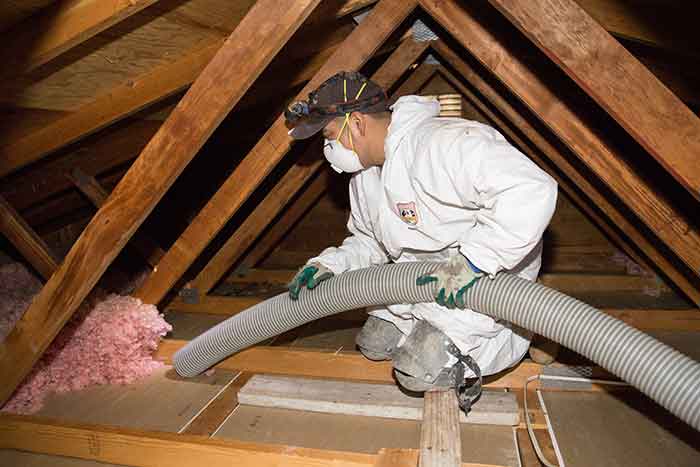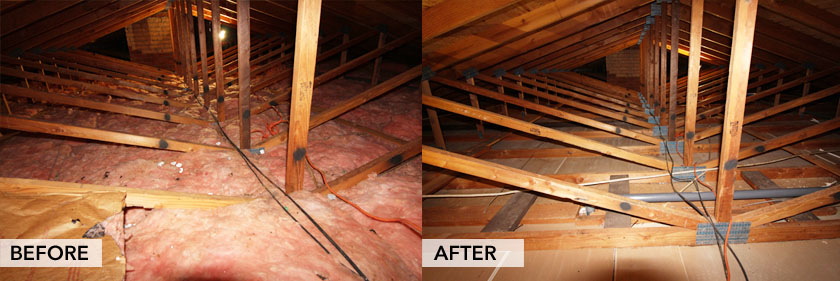Insulation removal helps prevent mold and pest infestations by eliminating contaminated or deteriorating materials that hold moisture, harbor pests, and create unhealthy conditions inside walls, attics, and crawl spaces. When old or damaged insulation remains in place, it can trap humidity, provide nesting material for rodents, and allow hidden colonies of insects or fungi to grow undetected.
This article explains why removing insulation is a proactive measure in managing home health and preventing infestations. It also explores insulation-related hazards, compares material vulnerability to pests and mold, and outlines key decisions homeowners should consider before removal.
Why Insulation Removal Matters for Mold and Pest Prevention
Eliminates Moisture-Holding Materials
Moisture is the root cause of mold growth. Older insulation—especially cellulose or fiberglass—can absorb and retain moisture due to roof leaks, poor ventilation, or condensation. This creates a breeding ground for mold spores, which can spread through air systems and impact indoor air quality.
Removes Hidden Pest Habitats
Rodents, insects, and bats often nest in insulation, especially in attics or crawlspaces. They leave behind urine, feces, and chewed material, which contaminates insulation and surrounding areas. Removing this compromised material eliminates the nesting site and exposes points of entry for sealing.
Technical Data and Material Vulnerabilities
Insulation Type
Mold Resistance
Pest Resistance
Moisture Absorption
Common Issues When Contaminated
Fiberglass (Batt/Blown-In)
Moderate
Low
Moderate
Mold growth, pest nesting, sagging
Cellulose
Low
Very Low
High
Mold colonization, fire risk if untreated
Rockwool
High
High
Low
Rarely supports mold or pests
Spray Foam (Closed-Cell)
Very High
High
Very Low
Air barrier, rarely removed unless damaged
Cotton/Denim
Low
Low
High
Attracts insects, retains water
Comparison of Removal Scenarios
Condition Detected
Is Removal Recommended?
Reason
Mold visible on insulation
Yes
Mold spores can spread; insulation can't be cleaned
Rodent activity in attic
Yes
Contamination from droppings and nesting
Wet insulation after leak
Yes
Retains moisture, promotes mold and odor
Fire-damaged insulation
Yes
Contains smoke particles and soot
Old insulation in good shape
Not always
Only if updating energy efficiency or re-insulating

How Mold and Pests Thrive in Old Insulation
Mold Risk Factors
- Poor ventilation in attics and crawlspaces allows humidity to build.
- Roof or pipe leaks introduce water directly into insulation.
- Organic-based insulation, like cellulose, feeds mold spores once wet.
Pest Attraction Points
- Insulation provides warmth and cover—ideal for nesting.
- Materials like fiberglass or cotton are easy to tunnel through.
- Droppings and urine soak into insulation and attract other pests or bacteria.
Things to Consider Before Making a Decision
Type of Infestation or Damage
- If mold is only on the surface or drywall, insulation may not need full removal.
- Severe pest infestations almost always require insulation replacement.
Type of Existing Insulation
- Loose-fill types are harder to clean and more likely to be contaminated.
- Spray foam, if intact and dry, usually does not need removal unless structurally compromised.
Access and Cost
- Removal in crawlspaces or narrow attic areas is more labor-intensive.
- Costs increase with square footage, access difficulty, and hazardous contamination (e.g., rodent droppings or black mold).
Local Climate
- In humid areas, insulation that absorbs water (like cellulose) becomes a liability.
- Mold risk is significantly higher in regions with poor ventilation and seasonal humidity swings.

Market Insight
A 2023 EPA-funded study found that homes with untreated insulation damage were 58% more likely to report recurring mold issues within five years. Similarly, pest control industry surveys indicate that nearly 30% of rodent infestations in homes originate from attic insulation that provides undetected access and shelter.
Common Questions
What happens if contaminated insulation is left in place?
Contaminated insulation can harbor mold spores and pest waste. Over time, it may worsen indoor air quality and damage adjacent building materials.
Can I spot mold or pest damage myself?
Sometimes. Look for dark stains, musty smells, visible droppings, chewed material, or insulation clumping. A professional inspection ensures full assessment.
Is insulation removal noisy or messy?
Yes. Removal generates dust and noise, especially with blown-in insulation. Proper containment, HEPA vacuums, and protective gear are essential.
Does insulation removal include disinfection?
It should. After removal, affected areas need to be cleaned and disinfected to prevent regrowth or lingering odors before new insulation is added.
Bonus Tips
- Tip #1: After removal, install vapor barriers in crawlspaces or attics to reduce future mold growth.
- Tip #2: Use pest-resistant insulation, like rockwool or closed-cell spray foam, when reinstalling.
- Tip #3: Inspect roof flashing and attic vents during removal to detect hidden leaks or entry points.
Topic FAQ
How often should insulation be inspected for mold or pests?
Inspect attics and crawlspaces every 1–2 years, especially after storms, floods, or during pest activity seasons (spring and fall).
What’s the safest way to remove old insulation?
Hire professionals. They use vacuums with HEPA filters and follow safety protocols to avoid exposure to mold spores or animal waste.
Is it cheaper to clean or remove insulation?
Cleaning is rarely effective. Removal is a one-time cost that ensures all contamination is gone and prepares the space for fresh insulation.
What insulation is most resistant to mold and pests?
Closed-cell spray foam and rockwool are top choices. They don’t absorb moisture, are dense, and don’t provide food sources for pests or mold.
Can insulation removal help with allergies?
Yes. Removing old insulation contaminated with mold, dust, or droppings improves indoor air quality and reduces allergens.
Make the Right Decision
Removing damaged or contaminated insulation is essential for preventing mold spread and pest infestations in your home. It exposes hidden problems, eliminates harmful contaminants, and makes room for healthier, more effective insulation.
Evaluate your home's insulation based on its condition, age, and exposure to moisture or pest activity. If in doubt, a professional inspection can confirm whether removal is needed and help restore your home's safety and comfort.
Author and Reviewer:
Author: With 15 years of banking experience and five years managing H&R Foam Insulation, Edith is passionate about building strong relationships with customers. Her favorite part of the role is connecting with clients and ensuring their needs are met as she works alongside them to improve the health, comfort, and energy efficiency of their homes.
Reviewer: With 7 years in the spray foam insulation business, Ella Adams offered useful feedback on this post, helping make sure the tips were both realistic and easy to apply.





Comments